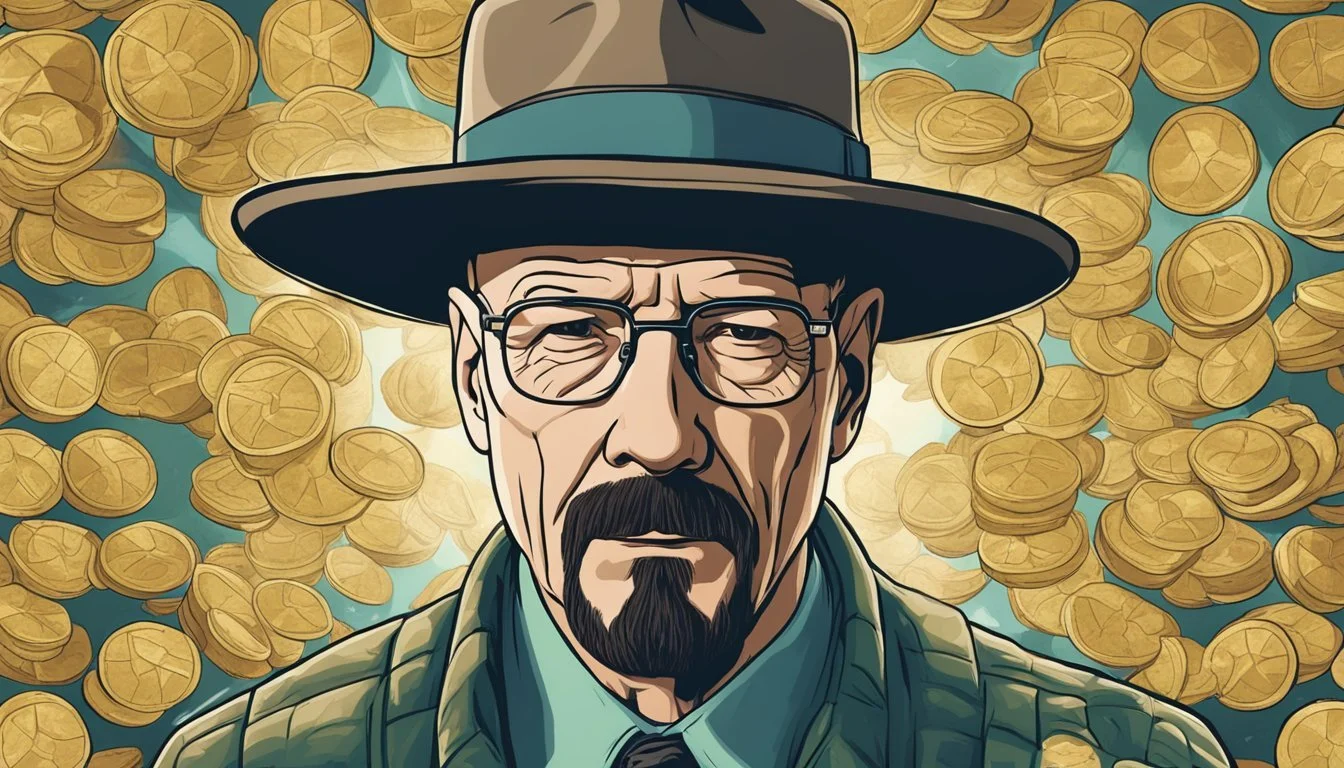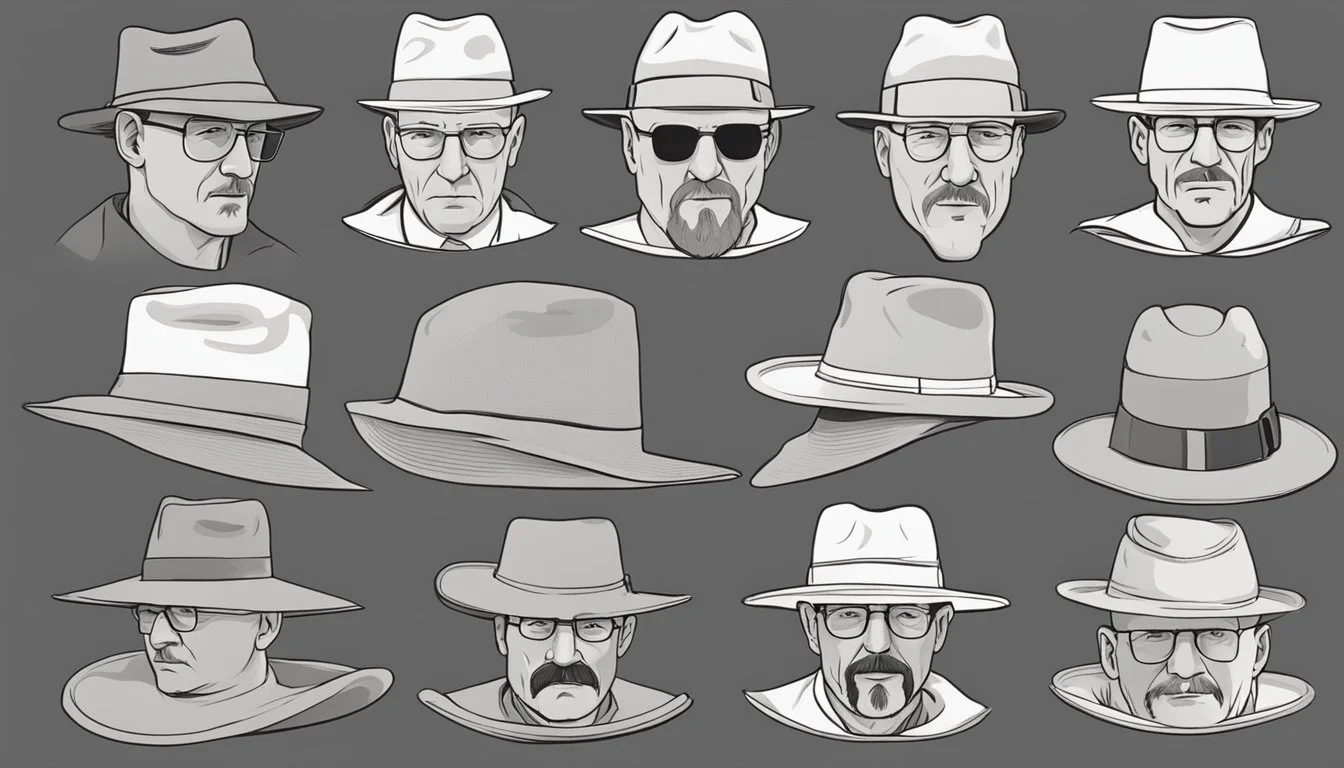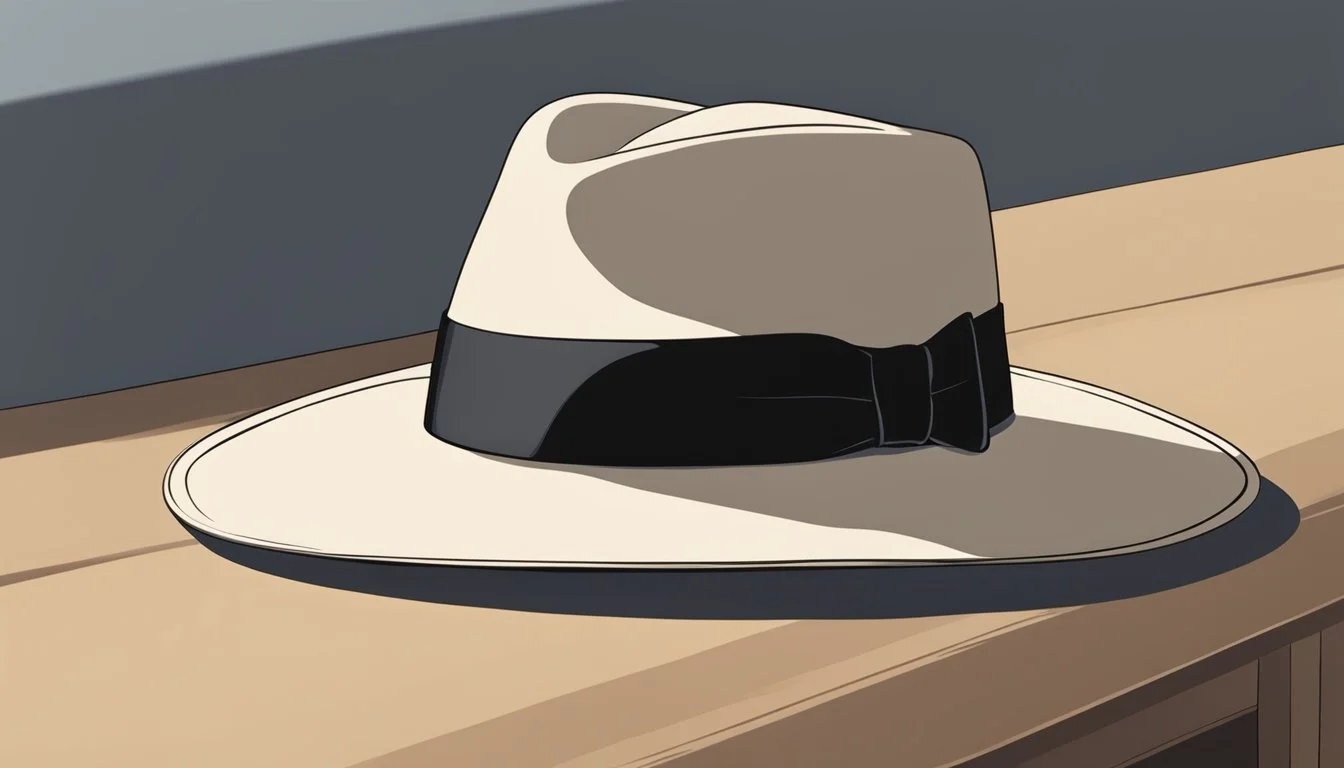The Symbolism of Walt's Hat: From Mr. Chips to Scarface in Breaking Bad
A Character Transformation Analysis
Breaking Bad's iconic portrayal of Walter White's transformation captivated audiences worldwide. The show's creator, Vince Gilligan, described this journey as going from "Mr. Chips to Scarface," referencing the stark contrast between a mild-mannered teacher and a ruthless drug lord. Walt's signature pork pie hat became a powerful symbol of his alter ego, Heisenberg, representing the gradual emergence of his darker nature.
This simple accessory played a crucial role in visualizing Walt's evolution throughout the series. When donning the hat, Walter White shed his timid persona and embraced the confident, dangerous Heisenberg. The hat served as a visual cue for viewers, signaling moments when Walt was fully immersed in his criminal activities.
The symbolism extended beyond Walt's personal transformation, reflecting broader themes of identity and morality in Breaking Bad. As the series progressed, the line between Walter White and Heisenberg blurred, raising questions about the true nature of his character. The hat became a tangible representation of the show's exploration of human capacity for change and the consequences of embracing one's darker impulses.
Walter White's Journey
Walter White's transformation from a mild-mannered chemistry teacher to the notorious drug kingpin Heisenberg is a central theme in Breaking Bad. This journey explores the depths of human nature and the consequences of moral compromise.
The Birth of Heisenberg
Walter White's alter ego, Heisenberg, emerges after his lung cancer diagnosis. Faced with mounting medical bills and a desire to secure his family's future, Walt turns to methamphetamine production. He adopts the pseudonym Heisenberg, inspired by the German physicist Werner Heisenberg.
This new identity allows Walt to separate his criminal actions from his role as a family man. The iconic black pork pie hat becomes a symbol of his transformation, signaling the shift from Mr. White to Heisenberg.
Walt's chemistry expertise proves invaluable in the drug trade. His product's purity and distinctive blue color quickly gain notoriety in the criminal underworld.
A Chemistry Teacher's Descent
Walt's background as a chemistry teacher plays a crucial role in his descent into the drug world. His deep understanding of chemical processes enables him to produce high-quality methamphetamine, setting him apart from other manufacturers.
Initially, Walt justifies his actions as necessary for his family's well-being. However, as he becomes more entrenched in the criminal world, his motivations shift. The thrill of power and recognition begins to overshadow his original intentions.
Walt's scientific mind also allows him to problem-solve in dangerous situations. He uses his knowledge to overcome obstacles and outsmart rivals, further cementing his position in the drug trade.
The Transformation of Identity
As Walt's involvement in the drug trade deepens, the line between Walter White and Heisenberg blurs. His once-mild demeanor gives way to ruthlessness and manipulation. Walt's transformation is reflected in his appearance, behavior, and decision-making.
The cancer that initially sparked his criminal journey becomes both a ticking clock and a twisted form of liberation. It allows Walt to break free from societal norms and embrace his darker impulses.
Family dynamics shift as Walt's secret life threatens to unravel. His wife Skyler becomes an unwilling accomplice, while his relationship with his son Walt Jr. grows strained. The journey from Mr. Chips to Scarface is complete when Walt fully embraces his Heisenberg persona, leaving behind the vestiges of his former self.
The Motifs of Breaking Bad
Breaking Bad employs a rich tapestry of visual motifs and symbols to convey deeper meanings throughout the series. These elements serve as powerful storytelling devices, highlighting Walter White's transformation and the show's key themes.
Symbols of Walter's Dual Life
The pork-pie hat stands as the most iconic symbol of Walter White's alter ego, Heisenberg. When donned, it signals his descent into the criminal underworld. The hat represents power, confidence, and Walter's embrace of his darker nature.
Walter's tighty whities, seen in the pilot episode, symbolize his initial vulnerability and ordinary life. As the series progresses, his clothing evolves to reflect his changing identity.
The pink teddy bear, first appearing after a plane crash, becomes a recurring motif. Its charred and damaged state foreshadows the destruction Walter's actions will bring to those around him.
The Iconography in Clothing
Walter's wardrobe undergoes a significant transformation throughout the series. His initial bland, beige clothing represents his unremarkable life as a high school teacher.
As Heisenberg, Walter adopts a darker color palette. Black becomes prominent in his attire, symbolizing his moral corruption and growing power in the drug trade.
Jesse's baggy clothing and vibrant colors contrast with Walter's style. This visual distinction highlights their different backgrounds and approaches to the drug business.
Recurring Visual Metaphors
The gas mask serves as a potent visual metaphor in Breaking Bad. It represents the dangerous nature of Walter's meth production and his attempts to shield himself from the consequences of his actions.
The fly episode uses the insect as a metaphor for Walter's obsession with control and perfection in his lab. It also symbolizes his guilty conscience and the contamination of his moral character.
Chemical formulas and scientific imagery frequently appear, reinforcing Walter's background as a chemist and the scientific precision required in meth production.
Walt's Heisenberg Hat
Walt's iconic porkpie hat becomes a powerful symbol of his transformation into the drug kingpin Heisenberg. This simple accessory marks his shift from meek chemistry teacher to feared criminal mastermind.
From Protection to Persona
The porkpie hat initially serves as Walt's disguise, shielding him from recognition during drug deals. As he grows bolder, it evolves into a key part of his Heisenberg persona. Walt dons the hat to signal his shift into criminal mode, separating his two identities.
The hat allows Walt to step outside himself and become someone new. When wearing it, he exudes confidence and authority that the timid Walter White never possessed.
A Symbol of Authority
As Heisenberg's reputation grows, the hat becomes a symbol of his rising power in the drug world. It strikes fear into rivals and commands respect from associates. The mere sight of the hat lets others know they're dealing with the legendary Heisenberg.
Walt uses the hat to intimidate and control. He puts it on before confrontations, silently announcing his dominance. The hat transforms him from unassuming teacher to formidable crime lord.
The Fall of the Kingpin
In Heisenberg's final days, the hat takes on a darker meaning. It represents how far Walt has fallen and the monster he's become. As his empire crumbles, the hat is a reminder of the ordinary man who turned into Scarface.
Walt's eventual separation from the hat symbolizes his loss of power. Without it, he's exposed as just Walter White again. The hat's absence in his last days shows Heisenberg's reign has truly ended.
The Supporting Cast's Influence
Walter White's transformation is deeply intertwined with the characters surrounding him. Their actions and relationships shape his journey from mild-mannered teacher to ruthless drug lord.
Jesse Pinkman's Role in Walt's Transformation
Jesse Pinkman serves as Walt's initial entry point into the drug world. Their partnership evolves from teacher-student to an increasingly complex dynamic. Jesse's street smarts complement Walt's scientific knowledge, enabling their rise in the meth business.
As Walt becomes more ruthless, Jesse often acts as his moral compass. Their relationship fluctuates between trust and betrayal, mirroring Walt's internal struggle.
Jesse's vulnerability and emotional ties to others contrast sharply with Walt's growing detachment. This difference highlights Walt's progression towards the "Scarface" persona.
Family Dynamics and Walter's Choices
Walt's family plays a crucial role in his motivations and decision-making. His initial justification for entering the drug trade is to provide for his family after his cancer diagnosis.
Skyler, Walt's wife, becomes increasingly aware of his illegal activities. Her reactions force Walt to confront the consequences of his choices on his loved ones.
As Walt's actions endanger his family, he must balance his desire for power with his role as a husband and father. This tension drives many of his most significant decisions throughout the series.
Adversaries and Catalysts
Walt's encounters with various adversaries accelerate his transformation. Tuco Salamanca introduces him to the violent realities of the drug world, pushing Walt to become more aggressive.
Gus Fring serves as both a mentor and rival. Their chess-like battle of wits forces Walt to embrace his cunning and ruthlessness fully.
These antagonists challenge Walt's intellect and survival instincts. Each confrontation strips away another layer of his "Mr. Chips" persona, revealing the "Scarface" beneath.
Walt's interactions with these characters test his limits and push him to embrace increasingly darker aspects of his personality.
Behind the Screen
Breaking Bad's iconic transformation of Walter White was shaped by visionary creators and performers. The show's success stemmed from meticulous planning and execution behind the scenes.
Vince Gilligan's Vision
Vince Gilligan, Breaking Bad's creator, pitched the show as turning "Mr. Chips into Scarface." This concise concept encapsulated Walter White's dramatic character arc. Gilligan drew inspiration from the 1939 film "Goodbye, Mr. Chips" and the notorious drug lord Tony Montana from "Scarface."
The vision required a delicate balance of storytelling and character development. Gilligan and his writing team crafted a narrative that allowed Walter's transformation to unfold organically over five seasons.
They explored themes of morality, power, and consequence, creating a complex world that resonated with audiences.
Bryan Cranston's Embodiment of Walt
Bryan Cranston's portrayal of Walter White was crucial to realizing Gilligan's vision. Cranston's nuanced performance brought depth and authenticity to the character's evolution.
He skillfully portrayed Walt's initial meekness and growing confidence as he embraced his alter ego, Heisenberg. Cranston's ability to convey Walt's internal struggles and moral decay earned him critical acclaim and multiple Emmy Awards.
His commitment to the role extended beyond acting. Cranston collaborated closely with the costume and makeup departments to physically transform alongside Walt's character development.
AMC and Breaking Bad's Legacy
AMC took a risk by greenl ighting Breaking Bad, a show with a morally ambiguous protagonist. The network's willingness to push boundaries paid off, establishing AMC as a major player in prestige television.
Breaking Bad's critical and commercial success paved the way for other ambitious series. It raised the bar for storytelling and production values in television.
The show's impact extended beyond its runtime. It spawned a successful spin-off, "Better Call Saul," and a sequel film, "El Camino." Breaking Bad's legacy continues to influence contemporary television and popular culture.
Themes and Symbolism
Walt's hat symbolizes his transformation and embodies key themes in Breaking Bad. It represents his journey from a mild-mannered teacher to a ruthless drug lord.
Walt's Pride and Downfall
Walt's pork pie hat becomes a symbol of his alter ego, Heisenberg. When he dons the hat, it signals his embrace of a darker, more ruthless persona. The hat reflects Walt's growing pride and ego as he builds his meth empire.
This headwear choice also foreshadows his eventual downfall. As Walt becomes more invested in his criminal identity, he loses touch with his former self and values. The hat serves as a visual reminder of how far he's strayed from his initial motivations.
Walt's obsession with being respected and feared in the drug world ultimately leads to his undoing. His pride blinds him to the consequences of his actions, pushing him further into danger and isolation.
The Consequences of the Drug Business
The black hat symbolizes the dark nature of the drug trade Walt enters. It represents the moral compromises and violence inherent in the business. As Walt wears the hat more frequently, it shows his deepening involvement in criminal activities.
His transformation is mirrored in the increasingly dangerous situations he faces. The hat becomes a visual shorthand for the risks and ethical dilemmas of the drug world. It highlights how the business changes Walt, eroding his ethics and relationships.
The contrast between Walt's ordinary life and his criminal activities is emphasized when he switches between wearing and not wearing the hat. This juxtaposition underscores the dual nature of his existence and the toll it takes on him.
Moral Ambiguity and Guilt
Walt's hat serves as a metaphor for the moral gray areas he navigates. When he puts it on, he steps into a world where right and wrong are not clearly defined. The hat becomes a way for Walt to compartmentalize his actions and distance himself from guilt.
However, this separation is not absolute. Even as Heisenberg, Walt struggles with the consequences of his choices. The hat can't fully shield him from the weight of his decisions or the impact on his soul.
In later seasons, Walt's increasing comfort with wearing the hat in various situations reflects his blurring moral boundaries. It symbolizes how his Heisenberg persona begins to dominate his identity, leaving less room for his former moral compass.
Impact and Reflections
Walter White's transformation, symbolized by his iconic pork pie hat, left an indelible mark on television and popular culture. The hat became a powerful visual metaphor for Walt's descent into criminality.
Cultural Reception and Critique
Breaking Bad's exploration of morality resonated deeply with audiences. Walt's hat served as a focal point for discussions about identity and the human capacity for change. Critics praised the show's nuanced portrayal of a man's gradual corruption.
The hat became instantly recognizable, sparking countless memes and Halloween costumes. Fans debated the ethics of rooting for an antihero, with the hat representing Walt's darker alter ego.
Albuquerque saw a surge in tourism as viewers sought out familiar Breaking Bad locations. The pork pie hat became a sought-after souvenir, solidifying its status as a cultural icon.
The Lasting Impression of Walt's Hat
The hat's symbolism extended beyond the show's finale. It continued to represent the duality of Walter White's character in popular discourse. The image of Bryan Cranston donning the hat became synonymous with complex TV protagonists.
Better Call Saul, the Breaking Bad spin-off, referenced the hat's significance. This reinforced its importance in the shared universe. The hat's legacy influenced character design in subsequent TV dramas.
Academics analyzed the hat's role in Walt's transformation from "Mr. Chips to Scarface." It became a case study in visual storytelling and character development.
Breaking Bad's Influence on Television
The show's impact on television storytelling was profound. Walt's journey, epitomized by his hat, raised the bar for character arcs in drama series. Breaking Bad's success paved the way for more morally ambiguous protagonists on TV.
The final season's tension was heightened by Walt's full embrace of his Heisenberg persona. This culminated in memorable scenes featuring the now-infamous hat. The show's influence extended to cinematography and pacing in other series.
Breaking Bad's critical acclaim and cultural impact set new standards for television drama. It inspired a wave of high-quality, character-driven series across networks and streaming platforms.







